MITSUBISHI ECLIPSE 1991 Service Manual
Manufacturer: MITSUBISHI, Model Year: 1991, Model line: ECLIPSE, Model: MITSUBISHI ECLIPSE 1991Pages: 1216, PDF Size: 67.42 MB
Page 1211 of 1216
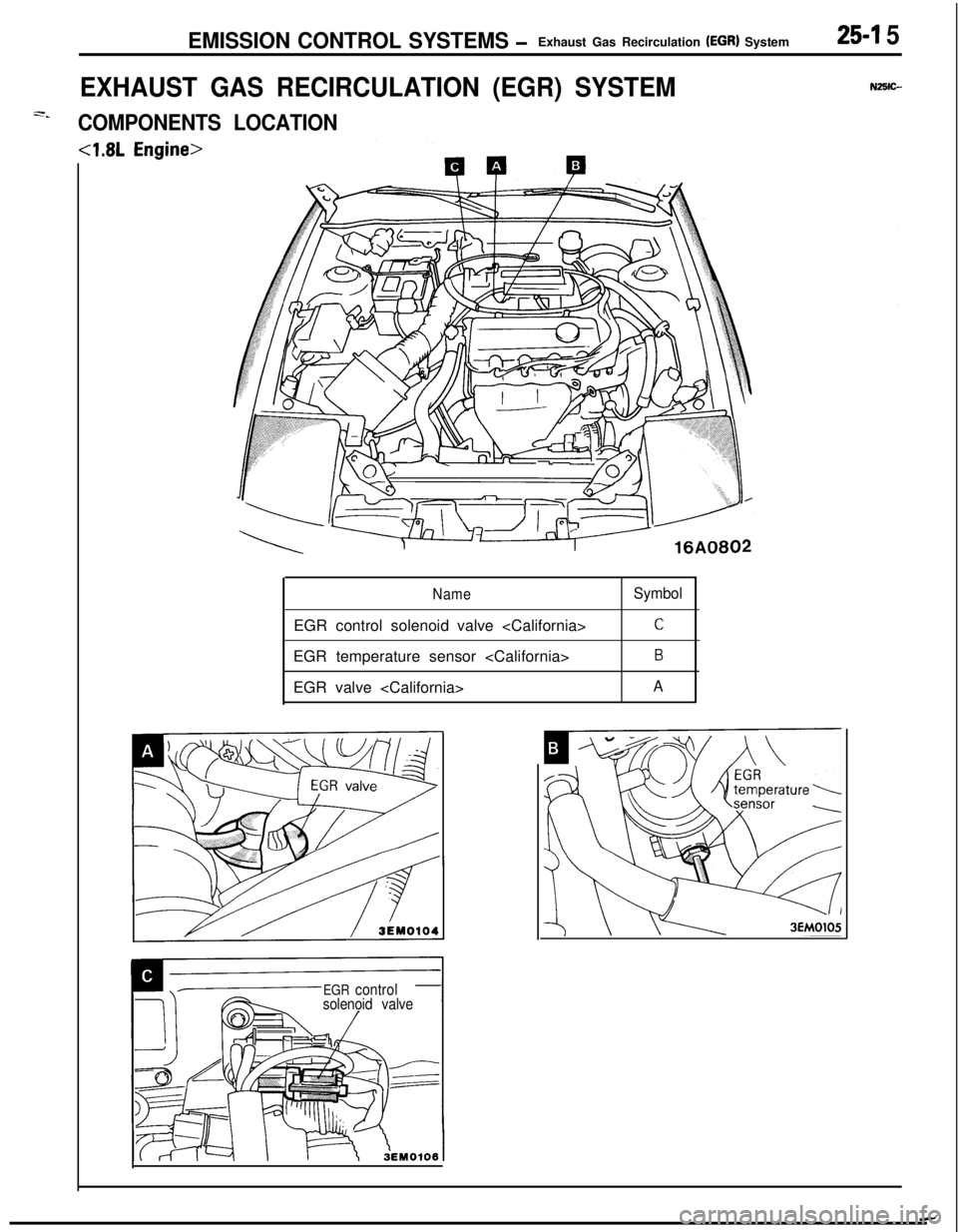
EMISSION CONTROL SYSTEMS -Exhaust Gas Recirculation (EGR) System25-l 5
EXHAUST GAS RECIRCULATION (EGR) SYSTEMN2!5lC-
2,COMPONENTS LOCATION
NameSymbolEGR control solenoid valve
CEGR temperature sensor
BEGR valve
A
EGR control
solenoid valve
Page 1212 of 1216
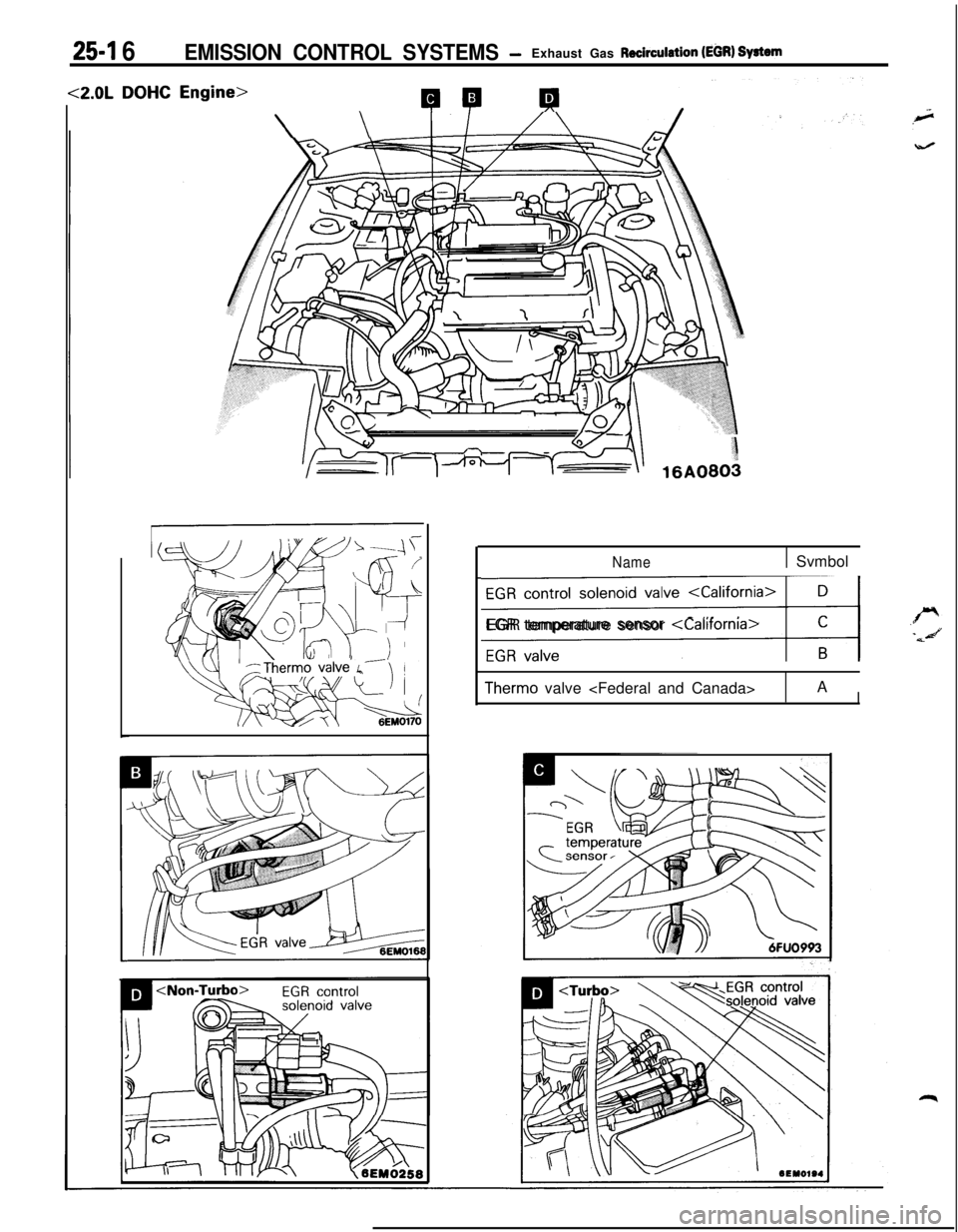
25-l 6EMISSION CONTROL SYSTEMS -Exhaust Gas Recirculation (EOR) SWem
4B
\\
‘\
16A0803
Name1 Svmbol
EGR control solenoid valve
D
IEGR temperature sensor
Therm0 valve
Page 1213 of 1216
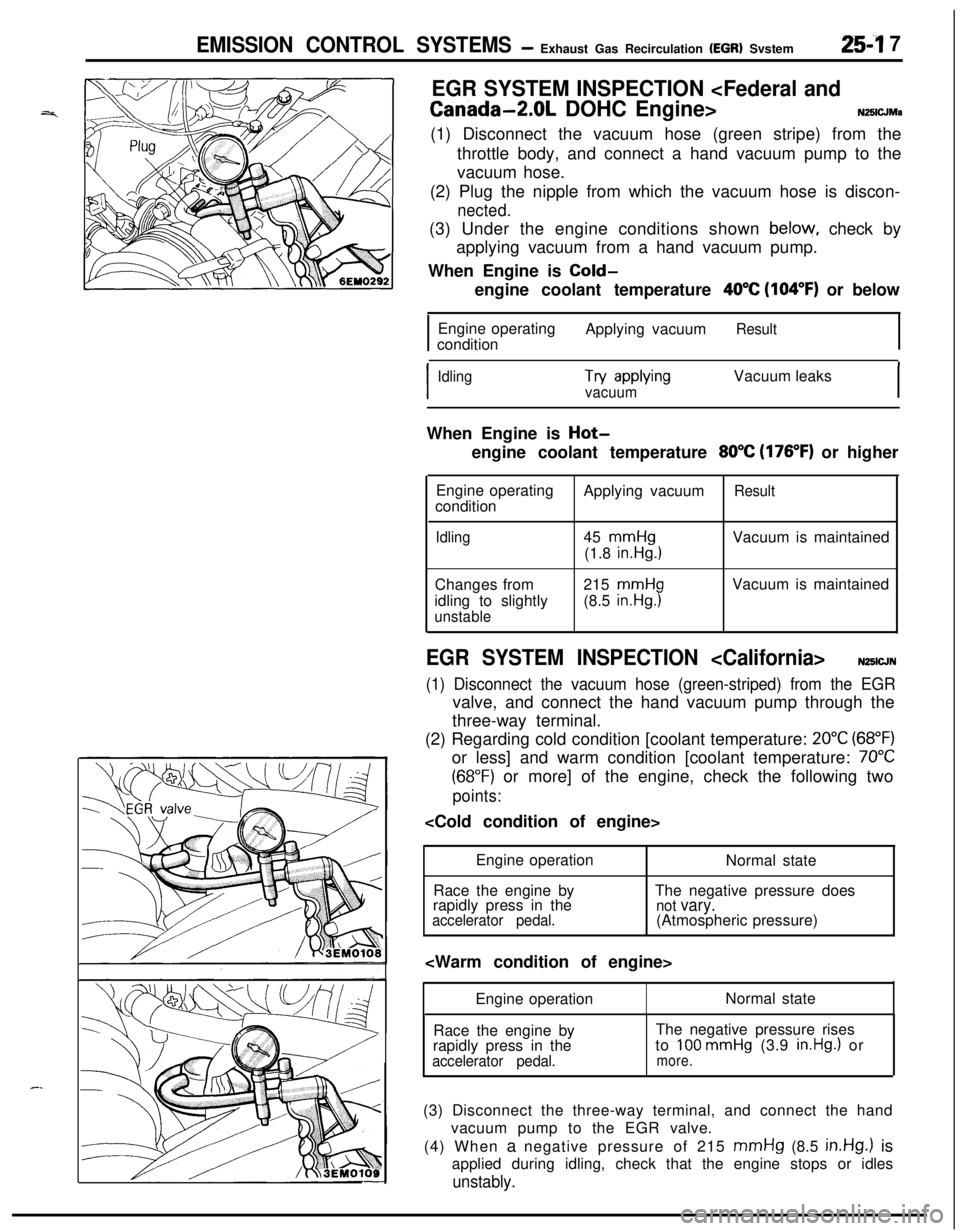
EMISSION CONTROL SYSTEMS- Exhaust Gas Recirculation (EGR) Svstem254 7
EGR SYSTEM INSPECTION
throttle body, and connect a hand vacuum pump to the
vacuum hose.
(2) Plug the nipple from which the vacuum hose is discon-
nected.(3) Under the engine conditions shown
below, check by
applying vacuum from a hand vacuum pump.
When Engine is
Cold-engine coolant temperature
40°C (104°F) or below
Engine operating
conditionApplying vacuum
Result
I
IdlingTry awMngVacuum leaksvacuumIWhen Engine is
Hot-engine coolant temperature
80°C (176°F) or higher
Engine operating
conditionApplying vacuum
Result
Idling45
mmHg(1.8
in.Hg.1Vacuum is maintained
Changes from
idling to slightly
unstable215
mmHg(8.5
in.Hg.1Vacuum is maintained
EGR SYSTEM INSPECTION
(1) Disconnect the vacuum hose (green-striped) from the EGRvalve, and connect the hand vacuum pump through the
three-way terminal.
(2) Regarding cold condition [coolant temperature:
20°C (68°F)or less] and warm condition [coolant temperature:
70°C
(68°F) or more] of the engine, check the following two
points:
Engine operation
Normal state
Race the engine byThe negative pressure does
rapidly press in the
not vary.accelerator pedal.(Atmospheric pressure)
Engine operationNormal state
Race the engine by
rapidly press in the
accelerator pedal.The negative pressure rises
to
100 mmHg (3.9 in.Hg.1 ormore.(3) Disconnect the three-way terminal, and connect the hand
vacuum pump to the EGR valve.
(4) When a negative pressure of 215
mmHg (8.5 in.Hg.) is
applied during idling, check that the engine stops or idles
unstably.
Page 1214 of 1216
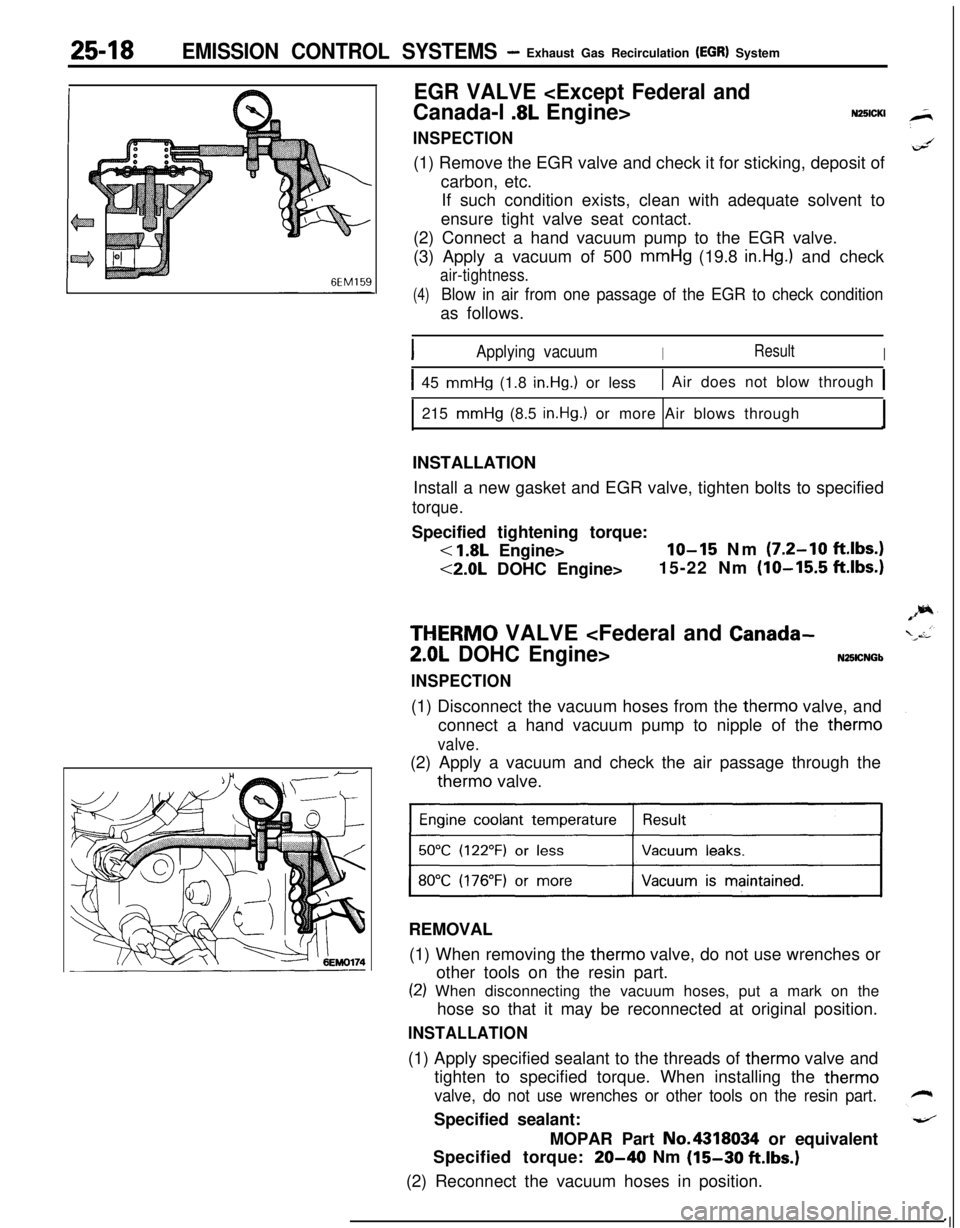
25-18EMISSION CONTROL SYSTEMS- Exhaust Gas Recirculation (EGRI System
EGR VALVE
INSPECTION(1) Remove the EGR valve and check it for sticking, deposit of
carbon, etc.
If such condition exists, clean with adequate solvent to
ensure tight valve seat contact.
(2) Connect a hand vacuum pump to the EGR valve.
(3) Apply a vacuum of 500 mmHg (19.8
in.Hg.) and check
air-tightness.
(4)Blow in air from one passage of the EGR to check conditionas follows.
IApplying vacuumIResultI
I45 mmHg (1.8 in.Hg.1 or less1 Air does not blow through 1215
mmHg (8.5 in.Hg.1 or more Air blows through
INSTALLATION
Install a new gasket and EGR valve, tighten bolts to specified
torque.Specified tightening torque:
< 1.8L Engine>lo-15 Nm (7.2-10 ft.lbs.)
<2.0L DOHC Engine>15-22 Nm (lo-155 ft.lbs.)
THERM0 VALVE
INSPECTION(1) Disconnect the vacuum hoses from the therm0 valve, and
connect a hand vacuum pump to nipple of the therm0
valve.(2) Apply a vacuum and check the air passage through thetherm0 valve.
REMOVAL
(1) When removing the therm0 valve, do not use wrenches or
other tools on the resin part.
(2) When disconnecting the vacuum hoses, put a mark on the
hose so that it may be reconnected at original position.
INSTALLATION(1) Apply specified sealant to the threads of therm0 valve and
tighten to specified torque. When installing the therm0
valve, do not use wrenches or other tools on the resin part.Specified sealant:
MOPAR Part No.4318034 or equivalent
Specified torque:
20-40 Nm (15-30 ftlbs.)(2) Reconnect the vacuum hoses in position.
‘I
Page 1215 of 1216
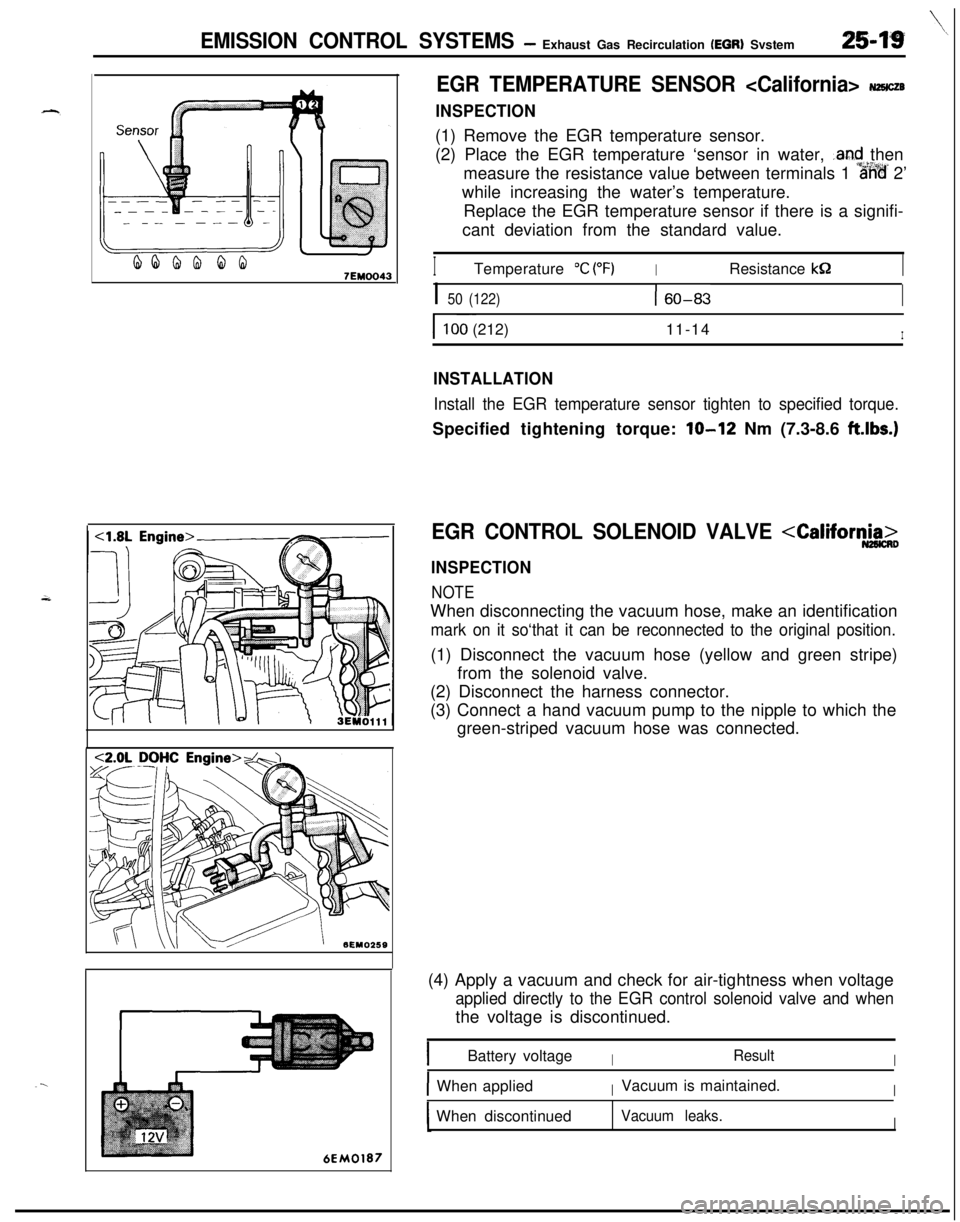
EMISSION CONTROL SYSTEMS- Exhaust Gas Recirculation (EGR) Svstem25-19
\\
7EM0043
. .
6EM0187
EGR TEMPERATURE SENSOR
INSPECTION(1) Remove the EGR temperature sensor.
(2) Place the EGR temperature ‘sensor in water,
.and then
measure the resistance value between terminals 1
%%’ 2’
while increasing the water’s temperature.
Replace the EGR temperature sensor if there is a signifi-
cant deviation from the standard value.
ITemperature “C (“F)IResistance kS2I
I 50 (122)160-83I
I ~~100 (212)11-14I
INSTALLATION
Install the EGR temperature sensor tighten to specified torque.Specified tightening torque:
lo-12 Nm (7.3-8.6 ft.lbs.)
EGR CONTROL SOLENOID VALVE
NOTEWhen disconnecting the vacuum hose, make an identification
mark on it so‘that it can be reconnected to the original position.(1) Disconnect the vacuum hose (yellow and green stripe)
from the solenoid valve.
(2) Disconnect the harness connector.
(3) Connect a hand vacuum pump to the nipple to which the
green-striped vacuum hose was connected.
(4) Apply a vacuum and check for air-tightness when voltage
applied directly to the EGR control solenoid valve and whenthe voltage is discontinued.
IBattery voltageIResultI
IWhen appliedIVacuum is maintained.IWhen discontinued
Vacuum leaks.I
Page 1216 of 1216
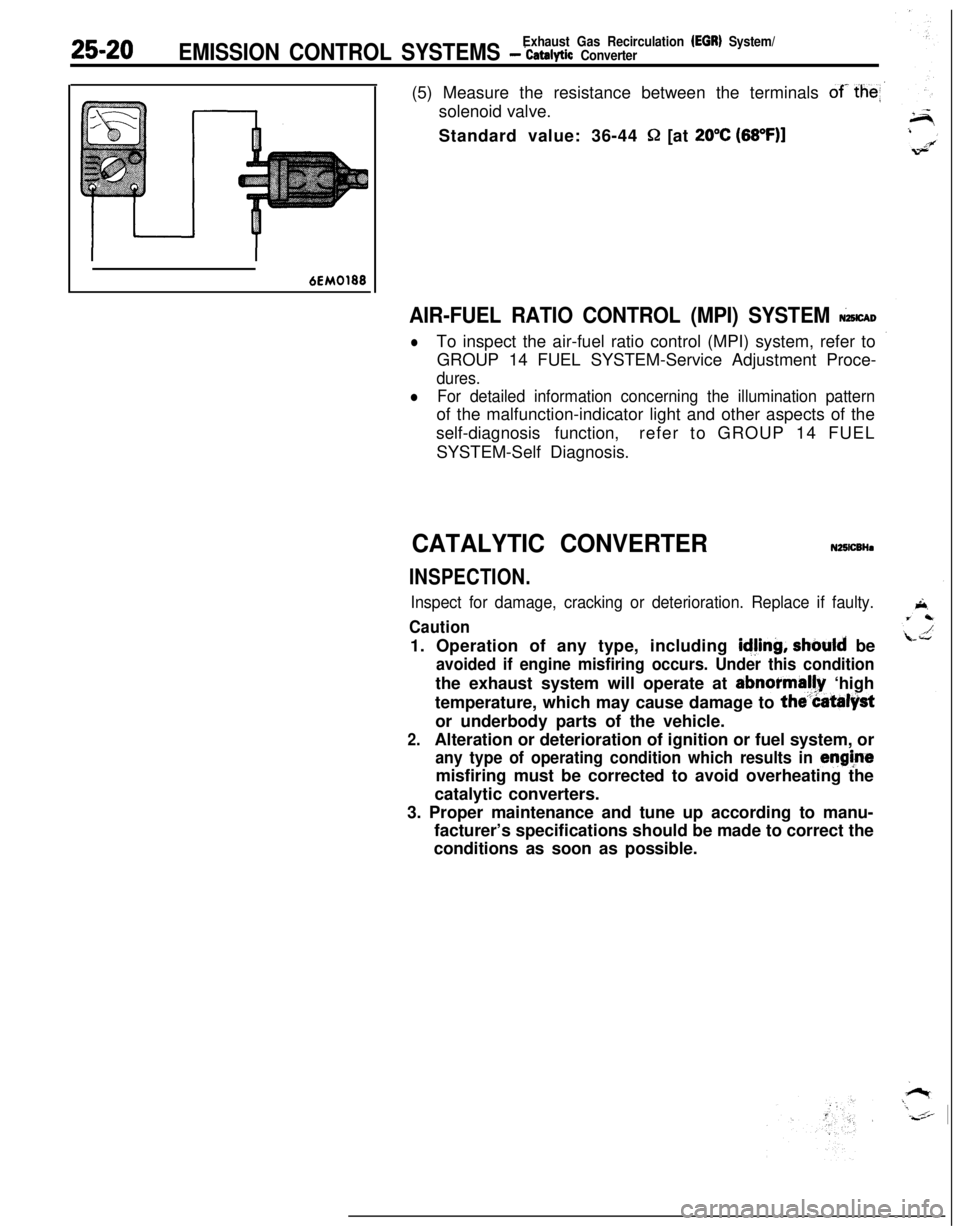
25-20Exhaust Gas Recirculation (EGR) System/EMISSION CONTROL SYSTEMS - ‘catalytic Converter(5) Measure the resistance between the terminals
of- the
Q [at 20°C (68OF)l
6EM0188
AIR-FUEL RATIO CONTROL (MPI) SYSTEM &CAD
lTo inspect the air-fuel ratio control (MPI) system, refer to
GROUP 14 FUEL SYSTEM-Service Adjustment Proce-
dures.
lFor detailed information concerning the illumination patternof the malfunction-indicator light and other aspects of the
self-diagnosis function,refer to GROUP 14 FUEL
SYSTEM-Self Diagnosis.
CATALYTIC CONVERTERN25lCBHa
INSPECTION.
Inspect for damage, cracking or deterioration. Replace if faulty.
Caution1. Operation of any type, including
idjing, should be
avoided if engine misfiring occurs. Under this conditionthe exhaust system will operate at abnormally ‘high
temperature, which may cause damage to
the”Catalystor underbody parts of the vehicle.
2.Alteration or deterioration of ignition or fuel system, or
any type of operating condition which results in enghtemisfiring must be corrected to avoid overheating the
catalytic converters.
3. Proper maintenance and tune up according to manu-
facturer’s specifications should be made to correct the
conditions as soon as possible.